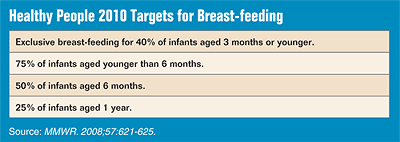Breast-feeding rate remains low among U.S. mothers
Discrepancies exist between accepted knowledge concerning the benefits of breast milk and maternity ward practice.
Additional public health efforts are needed to promote breast-feeding policies that adhere to current American Academy of Pediatrics recommendations and to reduce the practice of distributing infant formula samples to mothers on discharge may encourage breast-feeding practices.
“Hospital administrators, nurses, pediatricians and obstetricians need to realize that giving out sample packs is of no benefit to the patients,” Anne Merewood, MPH, director of the Breastfeeding Center at Boston Medical Center and member of the International Board of Lactation Consultant Examiners, told Infectious Diseases in Children. “Hospitals should not be responsible for marketing a product — especially a product that is not the preferred method of infant feeding.”

Data from two surveys, one conducted by researchers at the CDC, and another conducted by Merewood and colleagues at the Boston University School of Medicine, the Boston Medical Center and the Knox County Health Department in Knoxville, Tenn, indicated that feeding policies in U.S. hospitals and birth centers often disrupt exclusive breast-feeding practices and lack a solid evidence base.
Breast milk substitutes
Despite a 2005 policy statement from the AAP recommending that all infants be exclusively breast-fed until age 6 months and citing the multiple health benefits for mothers, children and the community as a whole, new data from the CDC’s first national Maternity Practices in Infant Nutrition and Care Survey indicated that 70% of 2,690 responding facilities provided discharge packs that included formula samples. Other practices that discourage breast-feeding were also identified:
- Providing supplemental feeding in addition to breast-feeding in more than half of all healthy, full-term infants (24%).
- Among those that supplemented breast-feeding, water (15%), glucose water (30%) and something other than breast milk (17%) were used as substitutes.
“Facilities should consider discontinuing these practices to provide more positive influences on both breast-feeding initiation and duration,” the CDC officials wrote.
An additional telephone survey conducted by Merewood et al designed to determine the distribution of sample formula packs in hospitals along the East Coast support the CDC’s findings and provide further insight into the matter.
The researchers called 1,295 hospitals in 21 Eastern states and the District of Columbia between Oct. 1, 2006, and March 31, 2007. An average of 93.8% of the hospitals surveyed identified that they distributed free formula. However, distribution rates varied, ranging from 70.4% in New Hampshire to 100% in the District of Columbia, Maryland, Mississippi, New Jersey and West Virginia. “Given the widespread condemnation of this practice by major medical authorities … it is disturbing to note its continued prevalence,” the researchers wrote.

Are samples unethical?
Merewood suggests that a symbiotic relationship between health care providers and formula companies may blur the lines between actual practice and ethical practice. “Most hospitals in this country take formula for free from the manufacturers,” Merewood said. She said there are incentives to take these samples, including free bottles, nipples, storage containers, glucose water, volufeeds and other expensive formulas needed in intensive care units.
Another reason for the disparity between breast-feeding recommendations and the high prevalence of formula distribution may be a simple lack of awareness on the part of providers. “These sample packs have been around for decades, [and] often no one questions why they are being given out,” Merewood said. “I have spoken to people who have given out free samples for their entire career and never realized what it implied until they were challenged to think it through.”
Changing embedded policies
Efforts from the New York City Department of Health and Mental Hygiene, the Massachusetts Department of Public Health and the Massachusetts Breastfeeding Coalition have made considerable advances to discontinue formula sample distribution. Even after the dissolution of a proposed statewide regulation that would have removed formula sample packs from all Massachusetts hospitals in 2006, many hospitals did away with the practice on their own initiative, the researchers wrote.
Additionally, the New York City Health and Hospitals Corporation removed discharge gift bags that contained sample formula packs and replaced them with alternate gift bags in 11 city hospitals, the researchers wrote. However, more research is needed into the best possible way to fund replacement discharge gift bags.
Resistance among hospital personnel who believe that discontinuing the practice is synonymous with depriving mothers of a valuable gift often can be the biggest obstacle to changing such policies. “Staff do not want to take away a free gift,” Merewood said. “In fact, the value of the formula inside is minimal. Formula is widely available at every supermarket, neighborhood store and from the Special Supplemental Nutrition Program for Women, Infants and Children. Infants will not starve because mom does not get a free sample at discharge.”
Merewood emphasizes that successful breast-feeding initiatives depend on ethical decisions made by groups of people or hospitals, because it is often difficult for one person or hospital to make a change. She advocates for increased awareness. “Health care professionals need to think beyond the box,” Merewood said. “Hospitals should market health and nothing else.” – by Nicole Blazek
For more information:
- AAP. Policy statement: breastfeeding and the use of human milk. Pediatrics. 2005; doi:10.1542/peds.2004-2491.
- CDC. Breastfeeding-related maternity practices at hospitals and birth centers — United States, 2007. MMWR. 2008;57:621-625.
- Merewood A, Fonrose R, Singleton M, et al. From Maine to Mississippi: Hospital distribution of formula sample packs along the Eastern seaboard. Arch Pediatr Adolesc Med. 2008;162:823-827.
